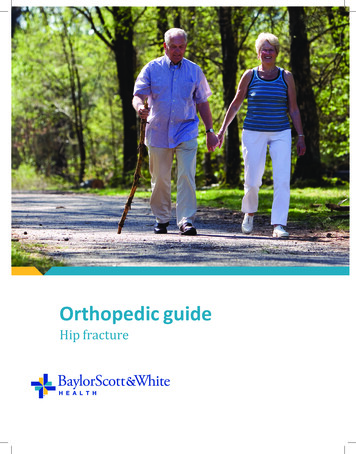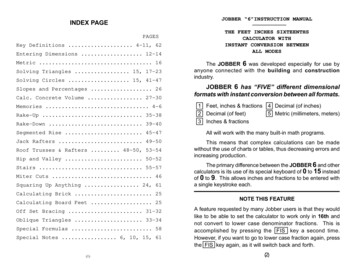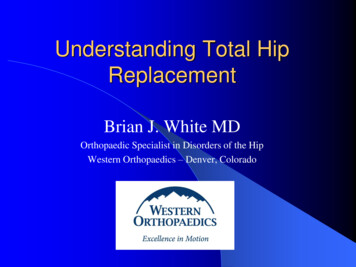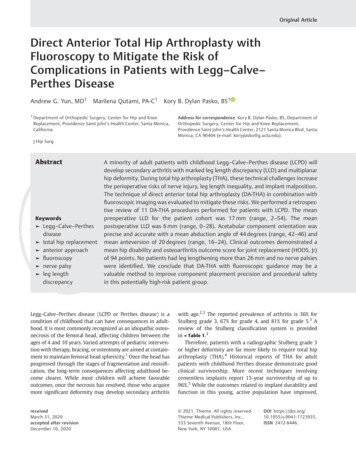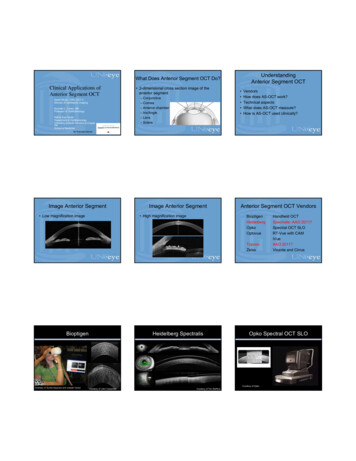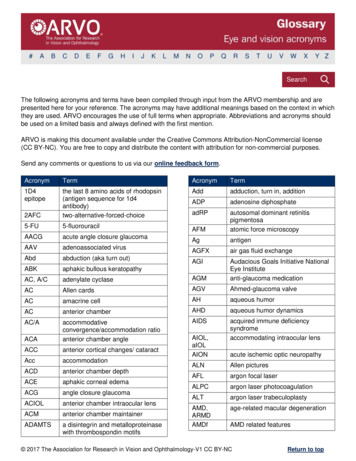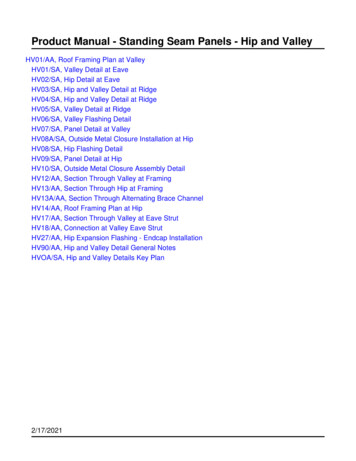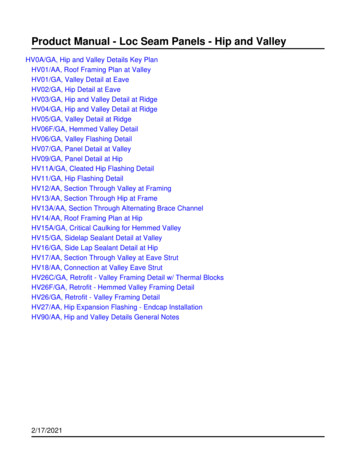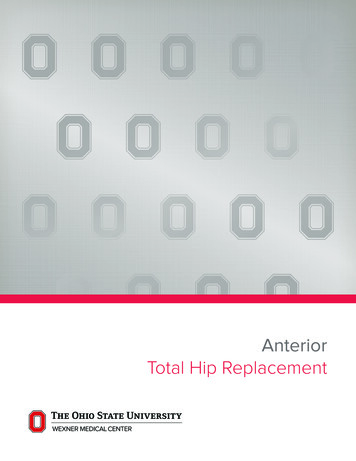
Transcription
AnteriorTotal Hip Replacement
Table of ContentsAbout Hip Replacement: Anterior Approach . 3Financial Issues . 5Dental Clearance.5Preparing for Surgery . 6Plan Now for Your Care After Surgery. 9Pain Management . 11Day Before and Morning of Surgery. 13Getting Your Skin Ready for Surgery. 14Having Surgery. 16Care on the Orthopedic Unit. 17In Hospital Care and Treatments . 19How to Use an Incentive Spirometer: Breathing Exerciser. 20Home Care Instructions. 21Exercises . 25Nutrition and Wound Healing . 28Using Your Walker . 30Using Your Cane . 37Using Equipment in Daily Activities. 39Other Important Information. 44For an electronic copy of this book, go to go.osu.edu/pted3972.Talk to your doctor or health care team if you have any questions about your care.For more health information, go to wexnermedical.osu.edu/patiented or contact the Library for Health Information at614-293-3707 or health-info@osu.edu. 2017 - July 30, 2021, The Ohio State University Wexner Medical Center
About Total Hip ReplacementAnterior ApproachTotal hip replacement is a surgery to replace worn or damaged parts of the hip joint. The surfacesof the joint are removed and replaced with an artificial joint. This surgery can relieve pain andimprove movement in your hip joint.You may need a total hip replacement if: Other treatments, such as medicine, steroid injections and physical therapy, no longer stopyour pain or help movement of the joint. Pain or poor movement in your hip prevents you from doing normal activities.Normal hip jointYour hip is a ball and socket joint where thethigh bone, called the femur, meets the hipbone or pelvis. A healthy hip has layers ofsmooth cartilage that covers the ball-shapedend of the femur and socket shaped part ofthe pelvis. The cartilage acts as a cushionand allows the ball of the femur to glideeasily within the socket of the pelvis. Themuscles around the joint support your weightand help move the joint smoothly.Worn hip jointThe smooth cartilage layers can wear downon the ball and socket part of the hip joint.The cartilage can wear down as you age, orfrom injury, arthritis, or as a side effect fromcertain medicines. When the joint wearsdown, the smooth surfaces become rough,like sandpaper. As you move your leg, theball grinds in the socket causing pain andstiffness.Images reproduced with permission from OrthoInfo. American Academyof Orthopaedic Surgeons. erior Total Hip Replacement3
Total hip replacementDuring surgery, the damaged cartilage and the ends of the bones of the hip joint are removed. Anew joint is created using an artificial cup and ball made of metal and very strong plastic. The cupreplaces the worn hip socket of your pelvis. The new ball is attached to a stem that fits into yourfemur and may be cemented in place with special bone cement. The metal has a porous surfacethat your bone will grow into as it heals to create a tight fit.Image reproduced with permission from OrthoInfo. American Academy of Orthopaedic Surgeons.http://orthoinfo.aaos.org.Anterior ApproachYour surgery will be done using the anterior approach. You will be positioned on your back for thesurgery. The doctor will make a 6 to 8 inch cut at the front of your hip to be able to get to your hipjoint. You will have hip precautions that you will need to follow for 6 to 12 weeks to protect yournew hip as it heals.Joint pain and movement after surgeryThe staff will help you stand and you will begin walking with a walker the day of or day aftersurgery.You will have some pain as the tissues heal and muscles regain their strength. This pain should goaway in a few weeks and pain medicine will be ordered to help relieve your pain. With your newjoint and physical therapy, you may be able to resume some of the activities you once enjoyed.4Anterior Total Hip Replacementwexnermedical.osu.edu
Financial IssuesCheck with your insuranceFinancial aidYour health insurance provider may requirepre-authorization for this surgery. Contactyour insurance company and talk to thestaff in your surgeon’s office.We will work with you and your family to helpyou get the care that you need.Please be prepared to pay your co-payment,co-insurance or deductible on the day ofyour surgery.If you do not have health insurance or cannotpay your bill, we encourage you to call ourFinancial Counseling Office at 614-293-2100or 800-678-8037. A staff member will be ableto help check if you might qualify for aid.If you insurance has less than 100%coverage, we ask that you pay a deposit of 300 before the procedure.They can help: Complete applications for governmentprograms.A representative from the hospital willcontact you to pre-register you for yoursurgery. If you have not received a call by 2days before your surgery date, please callour Pre-Registration Department at 614-2938200 or 866-312-7846. The representativewill be able to discuss both your doctor andhospital coverage and charges. Describe other programs that may offsetcosts. Figure out a workable payment plan forthe cost of your treatment.If you have MyChart, you can log on andcomplete a preregistration questionnaire.Ohio State Wexner Medical Center offers asliding scale financial assistance programbased on federal poverty guidelines thatwould be offered if you qualify.The financial counselor can also help youwith options related to the Affordable CareAct.Dental ClearanceSchedule an appointment with your dentist and take the formBecause the risk of infection could cause serious problems with your replaced hip, you need tohave a dental clearance visit. If you do not have a dentist, check with the surgeon’s office to see ifthey can help you find a dentist.If you are found to need any teeth removed or repaired, or if you have other problems with yourgums, teeth or dentures, your surgery may need to be delayed until the issues are treated andyou have healed.wexnermedical.osu.eduAnterior Total Hip Replacement5
Preparing for SurgeryReview these instructions as soon as youget them, so you are well prepared foryour surgery. Being well prepared can helpyou have a better recovery. Follow theseinstructions to keep your surgery on schedule.Call your doctor’s office if you have anyquestions.Attend Buckeye Joint ClassThis is a free 1-hour class to help you prepare.You must take this class before your surgery.Attend in person or online through Ohio State’sMyChart. You will learn what you: Need to do to get ready. Can expect during your hospital stay. Can do to get the best results from yourtherapy and recovery.In-person class: Offered every Monday afternoon at 3 PMat Outpatient Care East, Second floor, 543Taylor Avenue, Columbus, OH 43203 Register at your surgeon’s office, andconsider bringing your helper with you!You may have a visit with a provider (doctoror Advanced Practice Provider) a monthbefore surgery to go over expectations andrecovery from surgery.Weeks before surgery Review a list of all of your medicineswith your doctor. Be sure to includeall prescription and over the countermedicines, as well as any herbal orvitamin supplements you take. Youmay need to stop or change certainmedicines. If you take aspirin or medicines thatcontain aspirin, ask your doctor if youneed to take a different pain medicinebefore your surgery. If you are on blood thinners orantiplatelet medicines, please let yoursurgeon know in case the medicineneeds to be stopped or changed beforesurgery. This includes medicines such as: Arixtra (Fondaparinus) Brilinta (Ticagretor)Online Buckeye Joint Camp: Coumadin (Warfarin) Effient (Prasugrel) Eliquis (Apixiban) Fragmin (Dalteparin) Lovenox (Enoxaparin) Plavix (Clopidogrel)Pre-admission testing visit Pletal (Cilostazol)You will be scheduled for some tests to checkthat you are ready for surgery. You will have aphysical exam 1 to 2 weeks before surgery. Youwill also have blood tests, a chest x-ray, andmaybe an electrocardiogram, also called anECG or EKG, to check your heart. Pradaxa (Dabigatran) Savaysa (Edoxaban) Xarelto (Rivaroxaban) 6Registered through Ohio State’s MyChart.If you do not have MyChart, staff can assistyou at the Orthopedic Registration desk.Staff will provide instructions for how toregister and access the camp.Anterior Total Hip Replacementwexnermedical.osu.edu
If you have a stent or you have had ablood clot, talk to the doctor who placedthe stent or treated your blood clotbefore you stop taking this medicine.Your medicine may need to be changedor adjusted before surgery.If your surgery date gets changed,and you had stopped or changed yourmedicine to prevent clots, call yourdoctor. You may need to restart themedicine while you wait for your surgeryto be rescheduled. Stop hormone replacement or birthcontrol pills for 4 weeks before and 4weeks after surgery, unless you havebeen given other directions from yoursurgeon. Monamine oxidase inhibitors, alsocalled MAOIs, should be stopped 7 to 14days before surgery. Some of the drugsin this group include: Nardil, also known as phenelzinesulfate Parnate, also known astranylcypromine sulfate Eldepryl, also known as selequlinehydrochloride Stop all herbal medicines 7 days beforesurgery. These may include fish oil, garlic,or glucosamine for example. Stop taking non-steroidal antiinflammatory drugs, also called NSAIDs,for 5 days before surgery. Theseinclude diclofenac, Advil, Motrin, Aleve,Celebrex, Mobic, or any generic versionsof ibuprofen, naproxen, or meloxicam.Tylenol can be taken if needed.Other health issues If you get sick with a cold, sore throat,cough, or fever, or you have anyinfection before your surgery, callthe office right away. Your surgerymay need to be rescheduled until yourinfection is treated to avoid your newjoint getting infected. Have good eating habits and controlyour weight. If you are overweight, losingweight can make your recovery andrehabilitation easier. Avoid constipation. Talk to yourdoctor if you have had problems withconstipation. If you have not had a bowelmovement for a few days before yoursurgery, check with your doctor about alaxative or enema. If you are a smoker or tobacco user, youmust quit to heal well after surgery andreduce your risk of infection. Talk to yourdoctor about help to quit. Quitting at least 4 to 6 weeks beforeand up to 8 weeks after surgerywill help your surgical wounds healquicker and be less likely to getinfected. Oxygen is needed for wounds to healwell. Just 10 minutes of smoking candecrease the amount of oxygen intissue for up to 1 hour! Wound healing is harder in homeswith a smoker because the dressingsabsorb smoke. You will have a nicotine test beforesurgery. Your surgery may be cancelled ifit is positive. Stop taking any multivitamins or vitaminE for 3 days before surgery. Stop taking Glucophage, also known asmetformin, or any products that containmetformin for 48 hours before surgery.wexnermedical.osu.eduAnterior Total Hip Replacement7
Practice your exercises to work your leg muscles Do these exercises to strengthen your leg muscles and help prevent blood clots. Do these exercises lying on your back. Exercise both legs. Repeat each exercise 10 times, 2to 3 times each day, or as directed by your doctor, therapist or nurse. Breathe in as you tighten your muscles and out when you relax them. This helps keep yourmuscles relaxed. Breathe in normally when you hold a position. Continue these exercises after surgery, until you become more active.Ankle Pumping - strengthens your calf musclesin your lower leg.1. Bend your ankle, pulling your foot up towardsyour head.2. Push your foot back down, away from you asfar as possible, like you are pushing on thebrake pedal of a car.Quad Setting - works your upper leg or thighmuscles.1. Tighten the muscles of your upper leg.2. Keep your knee straight and push your kneedown into the bed. To get the idea, havesomeone place a hand under your knee. Pushyour knee down into the person’s hand.3. Hold for a count of 5, and then relax andrepeat.Gluteal Sets - works your buttocks muscles.1. Squeeze your buttocks together.2. Hold for a count of 5, and then relax andrepeat.Learn and practice coughing and deep breathingYour lungs are not working at their best after surgery. This is because of the length of time youare anesthetized or sleeping during your surgery. After surgery, the nurses will encourage you tocough and deep breathe to exercise your lungs.Practice these exercises to help strengthen your lungs before your surgery to decrease your riskof pneumonia after surgery. Repeat every 1 to 2 hours when you are awake.1. Breathe in slowly and deeply through your nose and hold for a few seconds.2. Purse your lips like you are going to blow out a candle and breathe out slowly.3. Repeat 5 times, and then take a deep breath in and cough.4. Do 3 sets of 5 breaths and a cough.In the hospital, you will be taught how to use a device for breathing exercises called an incentivespirometer. Using this helps prevent breathing problems, such as pneumonia.8Anterior Total Hip Replacementwexnermedical.osu.edu
Plan Now for Your Care after SurgeryYou will need some help to move around safely when you first leave the hospital after surgery. It iseasier to have a plan for help ready before you have your surgery.Plan for helpYou should have someone with you for the first few days after your surgery. Ask your familyand friends to be available to help: Give you a ride home from the hospital Get you in and out of the car Help you with bathing and exercising Get you into and out of bed Do laundry and light housekeeping Get you to your follow up appointments Collect your mail Care for your loved ones or petsOur goal is to have you go home after surgery.Prepare your home Prepare a room with all your equipment on the first floor, if possible. Arrange your furniture to have wide, safe walkways throughout your home. Remove clutter or throw rugs from the floor that may cause you to trip and fall. Clear away any foot stools, electrical cords, or other small items on the floor that could tripyou. Rearrange your kitchen to have those items you use often within easy reach. Shop for frozen or canned food that will be easy to prepare. Put non-skid strips or pads in your bathtub or shower for safety.Buy adaptive equipmentYou may need several pieces of equipment to make your daily activities easier and safer aftersurgery. Other pieces of equipment may be useful to you after surgery based on your needs.Most of the equipment is not covered by insurance, but check with your insurance companyto see what may be covered. You may be able to get some of the equipment from your localdrug store or medical supply store. Your social worker, case manager, or patient care resourcemanager (PCRM) will be able to help you with this.Your therapist will teach you how to use some of equipment before you go home.wexnermedical.osu.eduAnterior Total Hip Replacement9
Items you will need: Walker: Helps you to be safe when standing up andmoving. We recommend getting a walker beforesurgery, ideally a front wheeled walker.Other items that may be helpful to you: Elevated toilet seat: Attaches to your toilet seat to raisethe height. Cushion: Used to raise the seat height of a chair, carseat, or other surfaces. Reacher: Used to pick up items off the floor and to helpwith dressing.Elevated toilet seat Long-handled bath sponge: Helps you reach hard toreach areas when bathing. Shower chair or bench: Allows you to sit for yoursafety while you are in the tub or shower.Reacher Dressing stick: Used to help put on pants, skirts, pullup zippers and other things. Has a hook on one endand a pusher on the other. Sock aid: Helps you put on socks without having tobend forward so much.Bath sponge Long-handled shoe horn: Allows you to put shoes onwhile sitting or standing. Elastic shoe laces: Make it easier for you to slip in orout of your shoes. For some patients, a hospital bed may be needed whenyou first get home. Talk to your surgeon and physicaltherapist about your needs.Sock aidShoe hornBe safe at home10 Use an apron with several pockets or attach an apron to your walker tocarry things. Carry hot liquids in covered containers. Slide objects along the counter top instead of carrying them. Do not sit in swivel chairs. Use a reacher to reach objects on the floor or high in the cupboards.Anterior Total Hip Replacementwexnermedical.osu.edu
Pain ManagementMost people have some pain after surgery. Good pain control helps youfeel comfortable, so you can take deep breaths, walk and sleep. Thesethings help to lower your risk of problems, such as pneumonia and bloodclots after surgery. Take your medicine as ordered by your doctor to bringyou the most relief as your body heals.Starting before surgeryYour doctor may order medicine to help control your pain before surgery. These may include: Acetaminophen, brand name Tylenol Oxycodone, brand names Oxycontin, Oxecta, or Roxicodone Gabapentin, brand names Neurotin, Gralise, or Horizant Celecoxib, brand name CelebrexOther medicines may be ordered to control anxiety or to prevent nausea.Pain relief proceduresBesides oral medicines, your surgeon or anesthesiologist may recommend spinal analgesia foryour surgery to control pain. It can also help to control pain after surgery.Spinal Analgesia After cleaning and numbing the skin, a needle is put into the space around the spinal cord. Itdoes not go into your spinal cord. When the needle is in the right place, you will be given aninjection of pain medicine, and then the needle is removed. Rare side effects may include: headaches, numbness or tingling in lower legs, back soreness,bleeding, allergic reaction, or infection.Pain control after surgeryPain control is an important part of your overall treatment. Uncontrolled pain can interfere withsleep, healing, thinking, activity, and appetite. Ask for relief from pain before your pain worsens.You can expect some pain at the incision site and joint for several weeks after your surgery.You may also have some soreness in other parts of your body because of the way you werepositioned during surgery. Pain medicine and increasing your activity each day will help to easethe soreness. You will be asked about your pain often. You will be asked to rate your pain on a scale of 0 to10 with 0 being no pain and 10 being the worst pain. Your doctor will order medicine to help control your pain. Taking your pain medicine asordered by your doctor will bring you the most relief as your body heals. You may need to take your pain medicine before your exercises or activities to improve yourrecovery.wexnermedical.osu.eduAnterior Total Hip Replacement11
Our goal is to get your pain level to a 4 to 6 out of 10, so you can work with therapy.You will have pain after surgery. It will be worse for the first 2 to 3 weeks. We will prescribemedicines to help control pain, but you will still have mild pain after taking medicines.We will provide prescriptions for medicines at discharge, including pain medicines. If you needa refill before your 2 week visit, please call the office. We are unable to refill prescriptions onthe weekend or at night.You will need over the counter acetaminophen (Tylenol) 500 mg tablets after surgery. You willbe taking 1000 mg every 8 hours after surgery once you get home. Non-Drug Pain ControlMany patients find using other treatments helps to reduce the need for pain medicines. Some ofthese options may include: Activity: Start moving as soon as possible after surgery if your doctor says it is okay. Movinghelps your breathing and digestion, and helps you heal faster. Moving and being active canhelp lessen pain over time. Cold: Cold can help lessen some types of pain and is recommended after hip replacement. Itis best to use ice after exercise or if you have been very active. Use ice cubes, gel ice packs,or a device that pumps cold water through a sleeve that wraps around your joint, called GameReady or IceMan. Deep breathing: Taking slow deep breaths can help you relax and lessen pain. Distraction: Focus your attention on something other than pain. Playing cards or gamesand talking and visiting with family may relax you and keep you from thinking about the pain.Watching TV or reading may also be helpful. Music: Whether you listen to music, sing, hum, or play an instrument, music can help yourelax and help you breathe more deeply and slowly. It can also increase your energy and helpchange your mood. Aromatherapy: Uses essential oils to help support emotional, physical or spiritual well-being.People who use aromatherapy may use oils in different ways, such as breathing in essentialoils by using a room diffuser. Some use them with other products on the skin. Relaxation techniques: Stress and anxiety can make pain worse and may slow healing. Sinceit is hard to avoid stress, it can help to learn how to control it. Some ways to help you relax: Use extra pillows and blankets to stay in a comfortable position. Make sure the room is the right temperature for you. Ask your support person to massage your back, hands, or feet to lessen your pain. Try placing a cool cloth on your hands or face. Close your eyes and imagine yourself in a place you find relaxing. Think about sounds orsights that you enjoy.Relaxation resourcesListen to free audio recordings for guided imagery, mindfulness practices and relaxationtechniques at go.osu.edu/integrative-medicine-resources.Books and compact discs (CDs) on relaxation exercises can be found at libraries or bookstores.You may also find apps for your electronic device.12Anterior Total Hip Replacementwexnermedical.osu.edu
Day Before and Morning of SurgeryEvening before surgery Have an adult who will be able to bringyou to the hospital for your surgery. Gather items that you need to bring withyou in the morning: A photo ID. Insurance card or cards. Co-payment if required. A list of all medicines, includingprescription and over the counter,vitamins, herbal supplements, andany inhalers or drops you take. Besure to list the dose amount and thetimes you take the medicines. Walker with front wheels. Personal items that you may needfor an overnight stay. Include casesfor glasses, contacts, dentures, orhearing aids if you use them. CPAP machine if used for sleepapnea. This book.No eating or drinking aftermidnight You are not to eat or drink anythingafter midnight the night before yoursurgery. This includes no chewing gum,mints, or candy after midnight. Do not smoke anything after midnightthe night before your surgery. Smokingor chewing tobacco, or using anynicotine can delay wound healing andincrease your risk of infection aftersurgery. You may brush your teeth and rinse yourmouth after midnight, just be sure you donot swallow anything.Morning of surgery Also plan to leave these items at home: All valuables, such as your wallet,and purse. All jewelry including a watch, rings,and any form of piercing. Any pill bottles or homemedicines, unless you wereinstructed to bring them with you.Take a shower with CHG soap thisevening as instructed. Follow thedirections for Getting Your Skin Readyfor Surgery on the next pages.wexnermedical.osu.edu Take the medicines you were instructedto take with small sips of water. Thesemay include medicines for heart, bloodpressure, seizures, breathing, heart burn,gastric reflux, pain, depression, thyroid,or cholesterol problems. Do not take water pills, musclerelaxants, digoxin, unless it is forirregular heart beat, stool softenersor laxatives, vitamins or mineralsupplements, or fenofibrate. If you take insulin or other diabetesmedicine, check your blood sugar themorning of surgery. Only take yourinsulin as directed the morning ofsurgery.Take another shower with CHG asdirected. Be sure to avoid lotions,powder, or other skin products.Anterior Total Hip Replacement13
Getting Your Skin Ready for SurgeryBecause germs live on everyone’s skin, there is a chance of getting an infection when your skinis cut during surgery. To reduce the chance of infection, clean your skin with a special soap called4% chlorhexidine gluconate or CHG, sold by the brand name Hibiclens. You may be given or youwill need to buy a 8-ounce bottle or larger. Ask your pharmacist where to find it in the drug store.It is often with the first aid supplies. Do not shave for 1 week near the site for your surgery cut. Shaving with a razor can irritateyour skin and make it easier to develop an infection. If needed, the hair on the site will betrimmed with electric clippers before you go to the operating room. CHG soap does not bubble and lather like most soaps. Be careful not to get CHG into your eyes, nose, mouth, or ears. If you do, rinse well with cleanwater.Shower with CHG as directedFollow the steps on the next page for How to shower with CHG soap. You need to take 2 showers using CHG. Wash your whole body from the neck down withCHG soap the night before, and then again the morning of your surgery. Use 4 ounces (½ cup)of CHG soap each time you shower. Be sure to wash for 5 minutes and pay special attention to your hip site where your surgerywill be done. Be sure to wash the back of your neck, under your arms, your belly button,private parts, and your legs down to your toes. Do not scrub too hard.Please call your surgeon’s office if you have any questions.If you are not able to showerIf you do not have a shower or if you are not able to get into the shower, do a sponge bath withCHG soap instead.1. First, bathe with a washcloth and regular soap. Rinse with clean water.2. Wet a clean washcloth and apply 4 ounces (½ cup) of CHG soap to your whole body from theneck down for 5 minutes. Pay special attention to the part of the body where the surgery willbe done.3. Rinse well with another clean washcloth and plain water.4. Pat yourself dry with a clean, dry towel.14Anterior Total Hip Replacementwexnermedical.osu.edu
How to shower with CHG soap31Wash your hairas usual with yourregular shampooand then washyour body withregular soap.4Apply someCHG soapto the wetwashcloth.Use thewashcloth towash your wholebody from theneck down.Keep adding moreCHG and continueto wash for5 minutes.Rinse well.2Wet a cleanwashcloth.Turn offtheshower.55 min86Turn onthe showerwater andrinse yourwhole bodywell.Pat yourselfdry with acleantowel.SPRAYCREAM7Put onclean clothes.wexnermedical.osu.eduLOTIONNote: On the morning ofsurgery when you finishshowering, do NOT put onhair or skin care products,deodorant or make-up. DoNOT wear jewelry to thehospital or surgery center.Anterior Total Hip Replacement15
Having SurgerySurgery arrival timeOperating roomYou will get a call a day or two before yoursurgery to tell you what time you should be atthe hospital for your surgery. If your surgeryis scheduled for a Monday, you may be calledon Friday.Arrive on time, so we can prepare you forsurgery.You will be taken into the operating roomand all staff will wear gowns, caps, andmasks. The room lights will be bright andthe room will feel cool.A nurse in the operating room will greetyou and check your ID band. You will beasked some questions. A safety strap willbe put over you, so you stay on the table.Staff will talk to you to let you know whatthey are going to do next.You will be given medicine through your IVby anesthesiology to keep you pain freeand asleep during your surgery.You may have a tube placed into yourbladder to drain urine during surgery. Thistube will be removed the day after surgery.Your surgeon will replace the hip, and thenclose the incisions. A dressing will coverthe site.The time for your surgery is an estimate.Your surgery may take a longer or shortertime than you and your family were told.Your family can check a board in the waitingarea to see where you are. After surgery,the surgeon will talk with your family.Pre-operative holding area/ambulatory surgery unit (ASU) 16When you arrive in the pre-op holding areaor ASU, the nurse will talk to you and giveyou a gown to change into for surgery.Your clothes are put
wexnermedical.osu.edu Anterior Total Hip Replacement 3 thigh bone, called the femur, meets the hip . Normal hip joint Total hip replacement is a surgery to replace worn or damaged parts of the hip joint. The surfaces of the joint are removed and replaced with an artificial joint. This surgery can relieve pain and improve movement in your hip joint.

